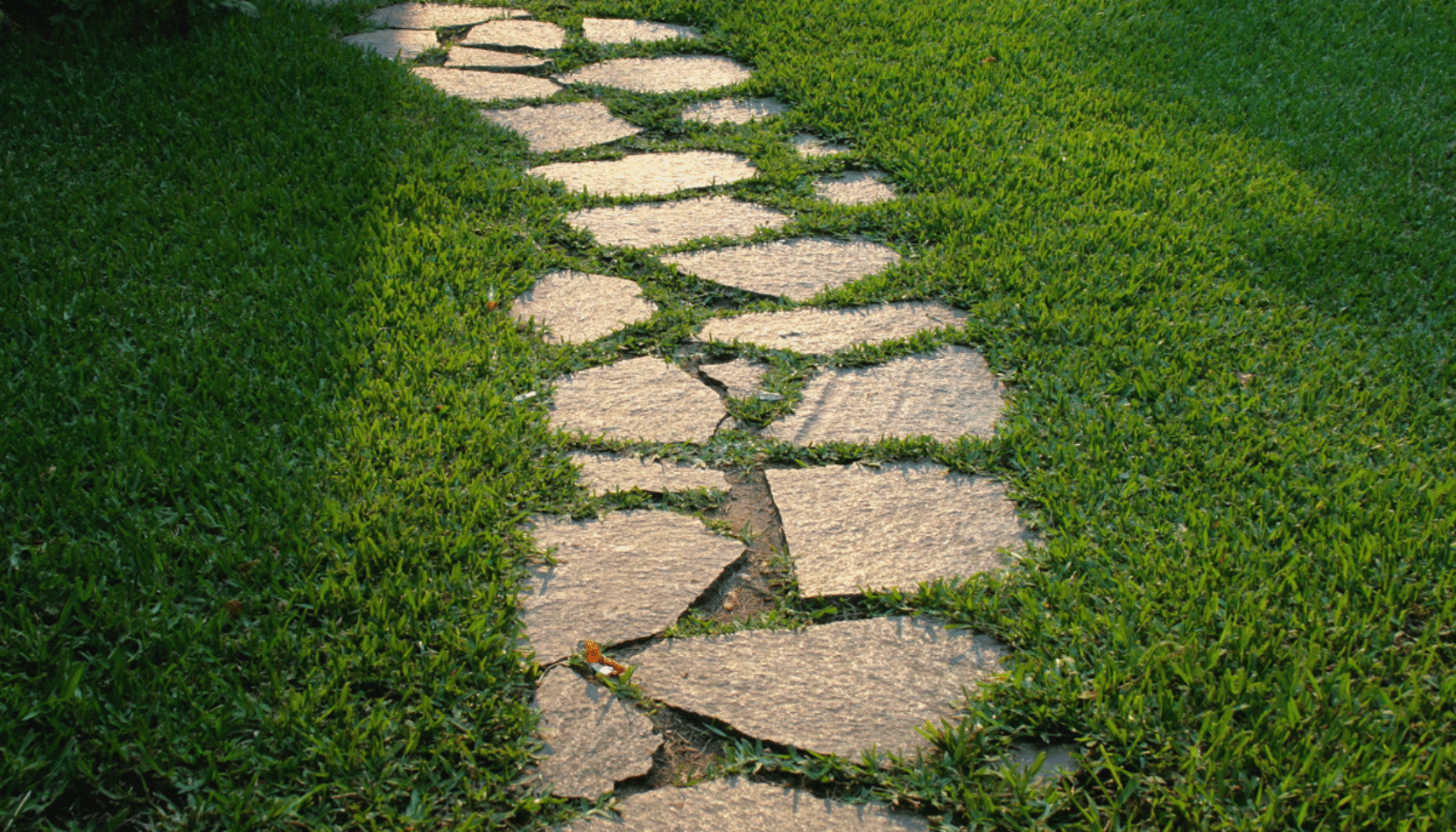GARDEN PATHWAY IDEAS
A garden path is more than just a walkway from one side of your garden to another – it is an integral design element that draws the eyes, defines the spaces, and adds character to your outdoor space. Whether you are picturing a grand walkway leading to a hidden retreat or a winding trail through a vibrant flower patch, a thoughtful path design can elevate your garden from beautiful to truly enchanting.
Below, garden design expert Calum Maddock at HomeHow.co.uk goes through some brilliant garden pathway ideas to help you elevate your garden’s appearance and functionality. Take a look at the list of great ideas below…
Rustic Natural Path
A rustic, natural path will blend seamlessly into your landscape and provide a feeling of calmness. You can achieve this with materials such as gravel, which offers excellent drainage and a satisfying crunch underfoot. Be sure to prepare the base with a weed barrier and compactable sub-base, and then add your chosen gravel. Create a subtle edging to contain the gravel.
Alternatively, you could create a whimsical stepping stone path using natural stone slabs, pre-cast concrete, or even large slices of wood. Lay them on a sand bed and allow the grass or groundcover to grow between them for a soft, integrated appearance. For a highly permeable, earthy surface, choose decomposed granite. This compacts firmly and can be installed over a permeable weed fabric. Another idea is an inexpensive and soft woodland path. Lay a thick layer of wood chip mulch or bark. This type of path will need regular replenishment.
Timeless Traditional Path
You can add a sense of timeless elegance and history to your garden path. For ensuring beauty and robustness, choose natural stone paths using flagstone for a rustic but classic feel. Alternatively, you could choose cut slate for a more refined appearance. Set them on a compacted gravel and sand base or even mortar for a very formal finish.
Alternatively, you can create a charming and enduring brick path laid in a classic pattern such as herringbone or basketweave. Make sure this is on a stable sub-base and sand or mortar bed, and sweep polymeric sand into the joints for more stability.
For a more classic feel, try concrete pavers. These are available in a variety of styles that mimic natural stone or brick. Install these on a compacted gravel and sand base and then compact them and fill joints with polymeric sand for a neat, durable finish.
Modern Minimalist Path
Another great idea is to create a sophisticated and striking pathway with clean lines, geometric shapes, and a contemporary aesthetic. A poured concrete path will allow for ultimate customisation. After preparing a solid sub-base and formwork, pour and smooth the concrete and perhaps add a colour or stamped texture to mimic large slabs.
For a crisp, expansive look, consider using large-format pavers and lay them with minimal gaps on a well-prepared, stable base to create a seamless geometric pattern. To introduce a bit of warmth to your modern minimalist design, consider adding some wooden stepping slabs or laying some decking planks. For stepping slabs, place durable wood pieces onto a gravel or sand bed. Alternatively, construct a simple sub-frame for decking planks, ensuring they are securely fastened for a clean, linear pathway.
If you would like a stark, defined modern edge, use steel edging to contain a path of gravel or decomposed granite, creating a precise boundary that sharply contrasts with the nature of the garden space.
Whimsical Path
Inject a unique charm and personality into your garden with paths that provide some whimsy. Consider a mosaic path by embedding broken ceramic tiles, colourful glass, or pebbles into a concrete base to create intricate patterns. For a truly enchanting effect, create a glow-in-the-dark path by incorporating phosphorescent pebbles or aggregates into concrete, gravel, or resin-bound surfaces, offering a magical luminescence after sunset.
You could also embrace a storybook feel with a living path where low-growing, resilient groundcovers like creeping thyme, chamomile, or moss are encouraged to grow between large, irregularly placed stepping stones. This creates a soft, fragrant walkway that changes with the seasons.
Functional Practical Path
In some cases, you may want to design a more functional path. This may be in cases where you need to prioritise utility, accessibility, and high traffic. Durability and ease of use will be important here. For heavy-duty use or vehicle access within the garden, consider reinforced concrete for your path. This can be poured thicker with rebar or mesh for extra strength and longevity.
When navigating changes in elevation, integrate stepped paths with sturdy materials such as timber, stone, or precast concrete steps. This will ensure a constant rise in safety and comfort.
For areas that require excellent drainage and a firm, low-maintenance surface, choose resin-bound paths. These involve mixing aggregates with a clear resin that then bonds them together, creating a smooth, permeable, and highly durable finish that is also ideal for wheelchair access.
Sustainable Water-Wise Path
If you want to create a sustainable, water-wise path, choose a path that supports water conversion and a healthy garden ecosystem by allowing rainwater to soak into the ground. A rain garden path can be designed by creating a slightly depressed path area lined with permeable materials like gravel or permeable pavers, allowing it to collect and slowly absorb runoff from surrounding areas. This will help to nourish nearby plants and reduce stormwater.
Make use of grass paver paths where a grid system is laid and filled with soil, allowing grass to grow through, providing a stable surface that supports light foot traffic or occasional vehicle use while maintaining a green space and excellent drainage. Embrace the simplicity of a mulched stepping path by laying large, irregularly shaped pavers or natural stones with wide gaps in between, then filling these gaps with thick layers of organic mulch such as wood chips or pine needles. These decompose slowly, enriching the soil and allowing water to penetrate easily.
Themed Aesthetic Path
Create a specific mood or journey through your garden with paths that enhance a particular theme or experience. For example, you can create a tranquil and contemplative space with a Zen garden path. This will use carefully raked white gravel or fine sand and will often be bordered with larger, strategically placed rocks, creating patterns that evoke ripples in water and encourage mindful walking.
Alternatively, you could create a sensory path by incorporating different textures underfoot with things like smooth pebbles, soft moss, rough bark, or cool flagstones, along with fragrant plants that brush against your legs, subtle water features, or wind chimes that engage hearing and lead visitors on a multi-sensory journey.
Alternatively, you could create a story path where the path itself guides visitors through a series of chapters, with each turn section leading to a new discovery. For example, you could come across a hidden bench, a unique plant, or a small sculpture. This allows you to create a curated narrative experience.
Final Thoughts
As you can see, your garden path is much more than just a way to get around. It is a powerful tool for shaping the very essence of your outdoor space. From the peaceful crunch of a rustic gravel path to the bold statement of modern large format pavers, or the playful surprise of a whimsical mosaic, each design choice offers you a unique opportunity to enhance both the beauty and functionality of your garden.
Whether you prioritise sustainability with a water-wise permeable surface or craft and immersive themed aesthetic path, careful planning and material selection can transform a simple walkway into a captivating journey. When you choose a path that resonates with your vision, you will not only elevate your garden’s appearance, but you will also enhance the experience of everyone who steps into your personal outdoor sanctuary.
MORE ABOUT THE AUTHOR… CALUM MADDOCK: Calum Maddock is a UK-based landscaper with over fifteen years of experience in the industry. As a gardening expert for HomeHow, Calum offers his expert advice to tradespeople and homeowners around the globe. He has also been featured as a gardening expert for a range of reputable publications.














